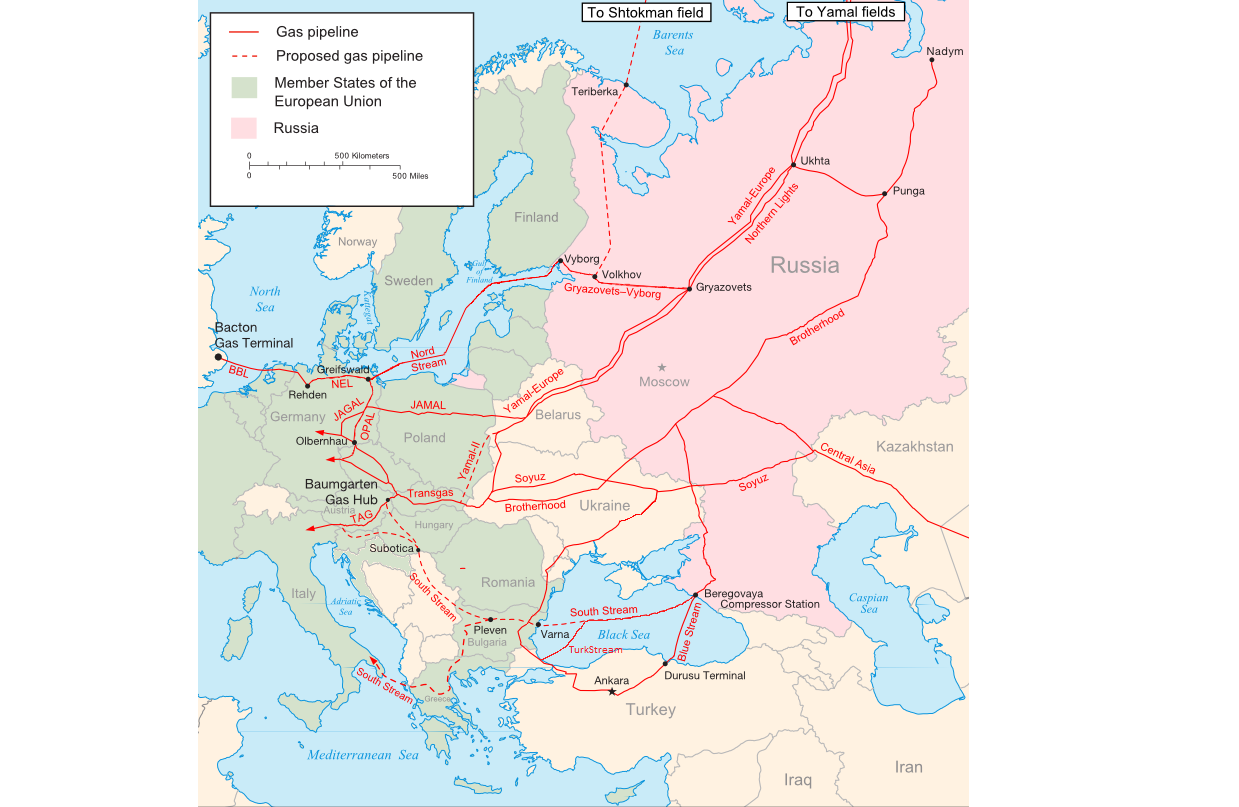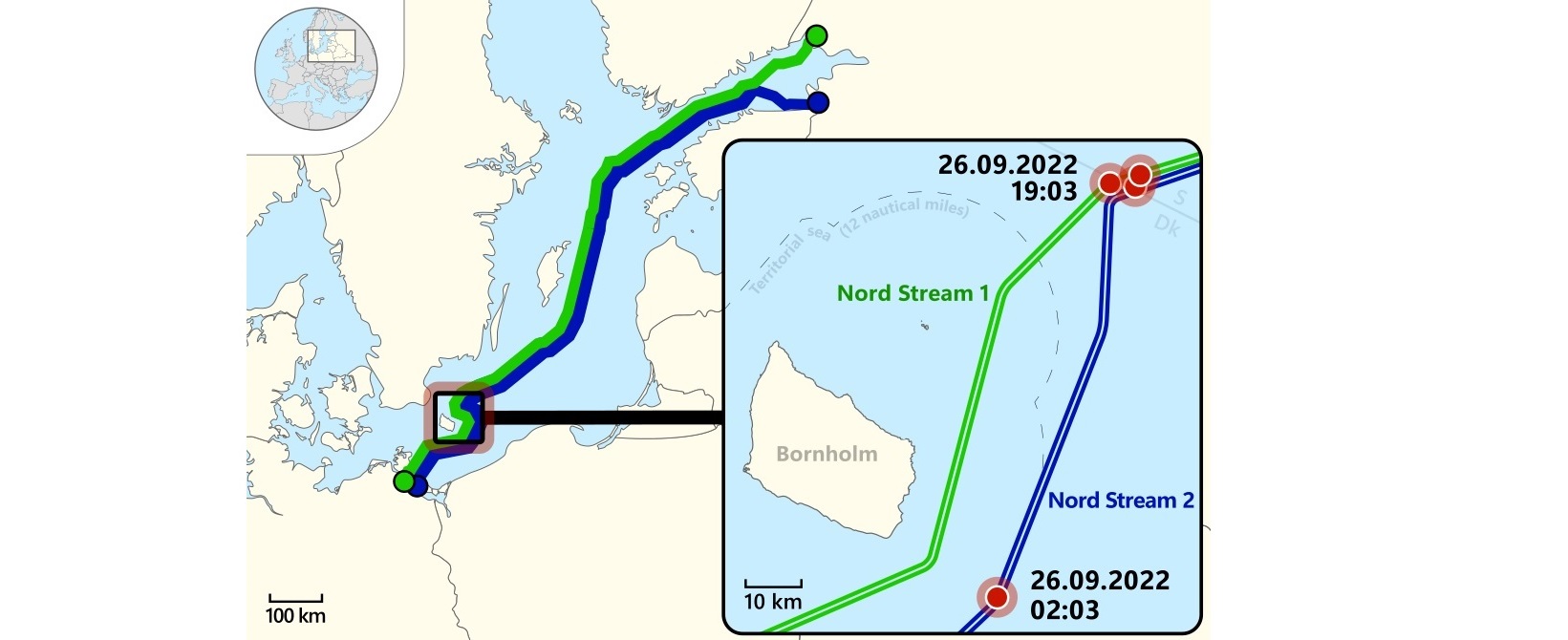
In 2021, Russia "was the largest exporter of oil and natural gas to the European Union" - according to Wikipedia. So what happens if there is a war, like the one with Ukraine?
The Ongoing War in Ukraine and Its Impact on Europe's Energy Supply
The ongoing war in Ukraine, which began in February 2022, has caused a massive geopolitical upheaval with profound consequences for the global order. However, among the most immediate and far-reaching effects has been its impact on Europe's energy supply. The war has led to significant disruptions in energy markets, altered supply chains, and forced European nations to reevaluate their energy dependencies, with particular attention paid to natural gas, oil, coal, and renewable energy transitions. This article explores the multifaceted impact of the war on Europe's energy supply, the measures taken to address these challenges, and the broader implications for Europe's future energy security and sustainability.
"On 26 September 2022, a series of underwater explosions and consequent gas leaks occurred on 3 of 4 Nord Stream pipes, rendering them inoperable.[8] The Nord Stream 1 (NS1) and Nord Stream 2 (NS2) are natural gas pipelines. They are two of 23 gas pipelines between Europe and Russia." Wikipedia

1. Pre-War Energy Dependence on Russia
Before the war, Europe had become heavily reliant on Russia for its energy needs. Russia was the European Union's largest supplier of natural gas, crude oil, and coal, making up approximately 40% of Europe's gas imports, 25% of its oil imports, and a significant share of its coal imports. Natural gas was particularly critical, used for electricity generation, heating, and as a feedstock for industrial processes. The EU’s energy strategy had, until then, been shaped by the availability of relatively cheap and abundant Russian energy resources, a situation that was maintained through a series of long-term agreements and infrastructure investments, such as the Nord Stream pipelines.
However, these energy ties became a double-edged sword. While Russia's energy exports were crucial to Europe's economic stability, they also represented a vulnerability. The war in Ukraine has exposed this dependency in stark terms, as it has not only disrupted energy flows but also placed energy security at the heart of geopolitical concerns.
2. Immediate Energy Disruptions
When Russia invaded Ukraine in February 2022, the immediate reaction in Europe was one of shock and horror at the scale of the military aggression. The European Union and other Western nations swiftly imposed sanctions on Russia in an effort to economically isolate the country and punish it for its actions. However, Russia's retaliation was swift and brutal: in the months following the invasion, Russia began to cut off gas supplies to many EU countries, starting with countries that had openly supported Ukraine or were seen as hostile to Russia.
The Russian gas cuts were felt most acutely in countries like Germany, Italy, and the Netherlands, which had relied heavily on Russian gas for their energy needs. In response to this reduction in supply, energy prices soared to unprecedented levels. European natural gas prices, already volatile due to supply constraints, skyrocketed, leading to energy crises in many EU member states.
The disruption of gas supplies from Russia had significant knock-on effects across the continent. Natural gas is an essential component of the European energy mix, not just for heating and electricity generation, but also for its role in industrial production. Industries such as chemicals, steel, and cement, which depend on affordable and reliable energy sources, were forced to cut back on production, raising concerns about job losses and economic slowdowns.
3. Rising Energy Prices
One of the most immediate and painful impacts of the war on Europe’s energy supply has been the sharp increase in energy prices. As Russia cut back on its natural gas exports, Europe turned to alternative sources of supply, including liquefied natural gas (LNG) from the United States, Qatar, and other suppliers. However, LNG is typically more expensive than pipeline gas, especially with rising global demand for natural gas, which led to significant price hikes.
Electricity prices also surged as natural gas prices increased, causing widespread inflation. The rising cost of energy has put enormous pressure on European households, especially in countries like Germany and Italy, where energy-intensive industries play a critical role in the economy. Governments across Europe scrambled to implement measures to protect consumers from skyrocketing energy bills, with various forms of financial aid, subsidies, and price caps being introduced.
In addition to the direct costs of energy, the soaring prices also had indirect consequences. Inflationary pressures mounted, and many economies saw reduced growth prospects, as both businesses and consumers were forced to cut back on spending. This economic slowdown further compounded the challenges for European governments, many of which were already grappling with the effects of the COVID-19 pandemic.
4. Energy Diversification and the Push for Energy Independence
The crisis caused by Russia's actions has prompted Europe to reevaluate its long-standing energy policy, which was based on cheap and abundant Russian energy. In response to the disruptions and in an effort to prevent future reliance on Russian energy, European countries have been working to diversify their energy sources.
Natural Gas and LNG Imports
As mentioned, Europe turned to LNG imports from alternative suppliers as a direct response to Russia's gas cuts. The United States, in particular, has become a significant supplier of LNG to Europe, with exports to the continent rising dramatically since the onset of the war. In 2022, the EU imported over 70 billion cubic meters of LNG from the United States, which helped mitigate the effects of Russian supply cuts. Similarly, Europe has worked to secure long-term gas supply agreements with countries like Qatar and Norway.
However, while LNG has offered a short-term solution, its higher price and logistical challenges, such as port capacity and shipping constraints, have made it an imperfect substitute for Russian pipeline gas. Moreover, the shift to LNG imports highlights Europe's continued vulnerability to global energy market fluctuations, which could make energy prices more volatile in the future.
Renewables and Energy Transition
In the medium to long term, Europe has been accelerating its investment in renewable energy sources like wind, solar, and hydroelectric power. The war in Ukraine has made clear the need for greater energy security through decarbonization, as renewable energy sources are not only sustainable but also shielded from the geopolitical risks associated with fossil fuels.
The European Union's Green Deal, which aims to make Europe the first carbon-neutral continent by 2050, has gained even more traction in light of the war. European governments are pouring more investment into renewables, increasing the pace of energy transition, and incentivizing green energy projects. Germany, for instance, has been accelerating its investments in offshore wind energy, while countries like Spain and Portugal have also ramped up solar energy development.
One of the most significant developments in this context has been the push for energy storage technologies, which are crucial for addressing the intermittency of renewable energy sources. Increased investment in energy storage, grid infrastructure, and interconnectivity between European countries is seen as a key enabler of energy transition in the coming decades.
Nuclear Energy
While renewable energy is seen as the future, the war has also triggered renewed interest in nuclear energy as a part of Europe’s energy mix. Countries like France, which already have a significant share of nuclear power in their energy supply, have seen a renewed focus on expanding nuclear capabilities. In countries like Germany, where the transition away from nuclear power was underway, the war has prompted debates about extending the life of existing nuclear plants as a way to secure energy supply in the short term.
While nuclear energy remains controversial due to safety concerns, waste management issues, and the initial capital investment required, it offers a stable, low-carbon energy source that can help reduce reliance on fossil fuels and provide grid stability in the event of future energy crises.
5. Geopolitical Shifts and the Role of Energy Security
The war in Ukraine has fundamentally altered the geopolitical landscape, and energy security has become a central issue for European policymakers. Europe’s reliance on Russian energy has been called into question, and many European nations are now exploring energy partnerships with countries outside of Russia's sphere of influence.
Countries like the United States, Norway, and Azerbaijan have become key energy partners for Europe, while there has been a renewed focus on strengthening energy ties with countries in North Africa and the Middle East. The EU has also been working to reduce its dependence on Russian energy through a series of strategic agreements and energy diversification plans.
However, the energy crisis has underscored the limits of Europe’s energy independence in the short term. Despite efforts to diversify energy sources and increase domestic production, Europe remains vulnerable to global market shifts, supply disruptions, and geopolitical risks.
6. Future Outlook and Challenges
The long-term impact of the Ukraine war on Europe’s energy supply will depend on several factors, including the outcome of the conflict, the success of energy diversification strategies, and the pace of the energy transition. While the war has accelerated Europe’s commitment to renewable energy and energy efficiency, challenges remain.
In the near term, Europe will continue to face high energy prices, as the global market adjusts to reduced Russian exports and increased demand for alternative sources. The transition to renewable energy is likely to take decades, requiring substantial investment in infrastructure, research, and development of new technologies. Moreover, there are ongoing debates about how to balance energy security with environmental goals, particularly when it comes to fossil fuel investments and nuclear energy.
In the long term, however, the energy crisis may be viewed as a pivotal moment in Europe's transition toward a more sustainable and secure energy system. The war in Ukraine has forced European nations to rethink their energy strategies, leading to greater cooperation, investment in renewables, and a more diversified energy mix. Whether this transition will be smooth or marred by geopolitical tensions, price volatility, and energy scarcity remains to be seen.
Conclusion
The war in Ukraine has had profound and far-reaching effects on Europe's energy supply. The disruption of Russian energy exports, soaring energy prices, and the drive for energy diversification have reshaped the European energy landscape. While the immediate challenges have been severe, the crisis has also served as a catalyst for long-term change. Europe’s energy future now hinges on its ability to accelerate its transition to renewable energy, reduce its reliance on fossil fuels, and ensure greater energy security through diversification and technological innovation. The road ahead is complex, but the war in Ukraine has undeniably set Europe on a path toward a more resilient and sustainable energy system.
You can learn these concepts and more at Dr Hock's maths and physics tuition.